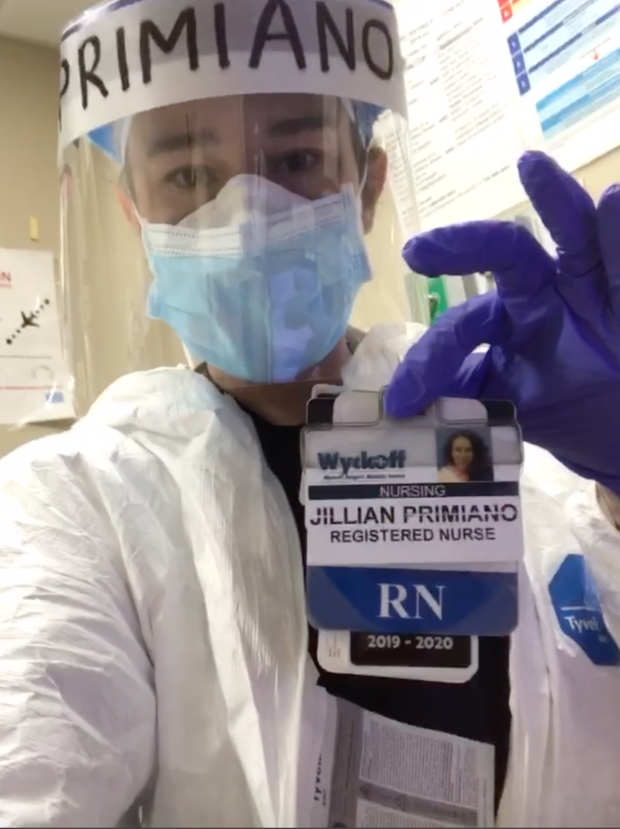Diary of an ER nurse in Brooklyn
Jillian Primiano is a nurse in the emergency room at Wyckoff Hospital in Brooklyn, New York. CBS News has confirmed her employment with the hospital and the details of the experiences she shared from these recent shifts.
Saturday, April 11:
My alarm goes off at 5:15 a.m. but I am already awake. Since coronavirus came to New York, I've been waking up early and abruptly, thinking of my patients, my coworkers, and our governor, Andrew Cuomo. My mind is full of COVID.
Yesterday, I had a sore throat and unusual fatigue. I check my temperature (not that it matters, many of the patients I see don't have a fever). It's normal. I finish my coffee and grab a size small N95 face mask that a friend sent (the ones we're being provided feel too loose on me) and some bleach wipes (we ran out of our usual ones).
I wonder if I'll leave in tears like I did the other day, when a lot of nurses were out sick with COVID symptoms.
I walk by three refrigerated semi-trucks on Stanhope Street housing our temporary morgue.
I'm assigned to a new unit today. Overnight last week, the pediatric emergency room was converted into another intensive care unit. Nobody wants to bring their kids to the hospital anymore, so the number of patients there has dropped to less than 20 per day.
Two pediatric nurses are on shift with me. "You're the mommy today," says Jessica (not her real name), who has been working with kids for more than 10 years and is now working with ICU-level adult patients. "We have no idea what we are doing."
Before COVID, this would be unimaginable, but now I'm thankful for the staffing we can get. At one point last week, I was caring for 10 patients, including two who had to be put on ventilators and a few who were close. That meant six minutes per patient per hour.
I start my rounds on the five patients we have today. The people on ventilators are out in the open — there aren't enough negative pressure rooms in the hospital for this tidal wave. I teach the pediatric nurses to take note of the ventilator settings, the vital signs, and the drip rates.
First, a male in his 60s. His heart stopped three times last night. His family has said he shouldn't be resuscitated again. Next, a male in his 70s. He's on sedation, vasopressors, and an insulin drip that requires us to take his blood sugar levels every hour. Next, a male in his 50s. Based on the level of oxygen in his blood, he seems to have the best chance of survival.
There are two non-ventilated patients — a young Type 1 diabetic who ran out of her insulin and got COVID at the same time, and a 50-something woman we're keeping in a precious closed room because she doesn't have COVID. She had a stroke and can't speak.
It's a long day with a lot of work. Everything is more than an hour late, but we make it through. The two other nurses work hard and do a great job. I don't cry on the way home.
Sunday, April 12:
At 3:30am, I wake up from a dream of a flat line on the monitor of one of our patients. I find out later that he died around that time. I get back to sleep, waking again in two hours to drink coffee, pack up a new N95 and walk to work. It's Easter, but I don't remember until I arrived in the lounge. One of the nurse techs says she just wishes she could go to church.
I'm triaging today — which means meeting emergency cases when they arrive — so I take my seat facing the ambulance bay next to Amy, one of the most experienced nurses in our department. Amy had been put on a ventilator with COVID symptoms early on in the pandemic and came back to work recently. She's sharing her experience with me when a woman in her Easter best shows up at the doors.
Amy holds up her hand and tells her to stay back. The air in the emergency room is full of COVID right now, and everyone inside wears an N95 mask. There are no visitors allowed in any New York City hospital except for birthing partners and people saying goodbye, but death usually comes so suddenly that there's no time for that.
The woman explains she wants an update on her husband, who came in yesterday, and she gives his name. Amy looks sad; I can tell she knows the patient. She steps back inside and explains to me that the man has had a stroke and she thinks he has a low chance of getting off his ventilator. She tells the woman to wait and gets the director of nursing to agree to let her into the hospital. Amy and Kathy, another veteran ER nurse, help the woman dress in full PPE — the PPE that is so valuable to healthcare workers — and come inside to say goodbye to her husband.
The day goes quickly. The patients are sicker but the volume has gone down since the last week of March, when it felt like it was at its highest. Paramedics are no longer allowed to bring people in cardiac arrest to the emergency room, so many patients who we would have seen are being pronounced dead at home.
It feels like four out of five patients we see have oxygen levels below 80% on room air. A few can't get above 80%, even when the EMTs give them supplemental oxygen. Many are referred by urgent care. One man saturating at 56% (this is like getting an F on a test) said he didn't come to the hospital before because he didn't want to bother us.
We have a husband and wife whose stretchers we place together. A patient we see at least three times a week with alcoholism and schizophrenia is now presenting with COVID symptoms. It seems each patient is sicker than the next. We work quickly to get them on wall oxygen and flip them on their stomachs (a position that helps oxygenation in COVID patients) to try to avoid, or at least delay, intubation. We hear "Code Blue, room 620," then 10 minutes later, "Code Blue, room 622." Code blue means a patient needs to be resuscitated. Just because we can keep these patients alive in the emergency room doesn't mean they'll survive their illness. I think about the nurses in the rest of the hospital, who have probably seen more death than I have.
The day finally ends. I pass the trucks and head home. It can't last forever.




